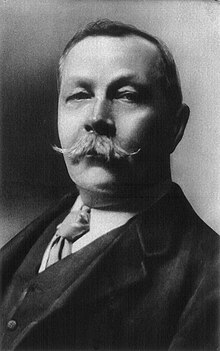About the Book: "The Adventure of the Yellow Face", one of the 56 short Sherlock Holmes stories written by British author Sir Arthur Conan Doyle, is the third tale from The Memoirs of Sherlock Holmes. It was first published in Strand Magazine in 1893 with original illustrations by Sidney Paget.
One of Doyle's sentimental pieces, the story is remarkable in that Holmes' deduction during the course of it proves incorrect. (Nevertheless, the truth still comes out.) According to Dr. Watson:
"...where he failed it happened too often that no one else succeeded... Now and again, however, it chanced that even when he erred the truth was still discovered."
About the Author: Arthur Ignatius Conan Doyle was born on 22 May 1859 at 11 Picardy Place, Edinburgh, Scotland. From 1876 to 1881, he studied medicine at the University of Edinburgh, including a period working in the town of Aston (now a district of Birmingham) and in Sheffield, as well as in Shropshire at Ruyton-XI-Towns. While studying, Doyle began writing short stories. His earliest extant fiction, "The Haunted Grange of Goresthorpe", was unsuccessfully submitted to Blackwood's Magazine. His first published piece "The Mystery of Sasassa Valley", a story set in South Africa, was printed in Chambers's Edinburgh Journal on 6 September 1879. On 20 September 1879, he published his first non-fiction article, "Gelsemium as a Poison" in the British Medical Journal. In 1882 he joined former classmate George Turnavine Budd as his partner at a medical practice in Plymouth, but their relationship proved difficult, and Doyle soon left to set up an independent practice. Arriving in Portsmouth in June of that year with less than £10 (£900 today) to his name, he set up a medical practice at 1 Bush Villas in Elm Grove, Southsea. The practice was initially not very successful. While waiting for patients, Doyle again began writing stories and composed his first novels, The Mystery of Cloomber, not published until 1888, and the unfinished Narrative of John Smith, which would go unpublished until 2011. He amassed a portfolio of short stories including "The Captain of the Pole-Star" and "J. Habakuk Jephson's Statement", both inspired by Doyle's time at sea, the latter of which popularized the mystery of the Mary Celeste and added fictional details such as the perfect condition of the ship (which had actually taken on water by the time it was discovered) and its boats remaining on board (the one boat was in fact missing) that have come to dominate popular accounts of the incident. Doyle struggled to find a publisher for his work. His first significant piece, A Study in Scarlet, was taken by Ward Lock Co. on 20 November 1886, giving Doyle £25 for all rights to the story. The piece appeared later that year in the Beeton's Christmas Annual and received good reviews in The Scotsman and the Glasgow Herald. The story featured the first appearance of Watson and Sherlock Holmes, partially modeled after his former university teacher Joseph Bell. Doyle wrote to him, "It is most certainly to you that I owe Sherlock Holmes ... Round the center of deduction and inference and observation which I have heard you inculcate I have tried to build up a man." Robert Louis Stevenson was able, even in faraway Samoa, to recognize the strong similarity between Joseph Bell and Sherlock Holmes: "My compliments on your very ingenious and very interesting adventures of Sherlock Holmes. ... Can this be my old friend Joe Bell?" Other authors sometimes suggest additional influences—for instance, the famous Edgar Allan Poe character C. Auguste Dupin. A sequel to A Study in Scarlet was commissioned and The Sign of the Four appeared in Lippincott's Magazine in February 1890, under agreement with the Ward Lock company. Doyle felt grievously exploited by Ward Lock as an author new to the publishing world and he left them. Short stories featuring Sherlock Holmes were published in the Strand Magazine. Doyle first began to write for the 'Strand' from his home at 2 Upper Wimpole Street, now marked by a memorial plaque. In this period, however, Holmes was not his sole subject and in 1893, he collaborated with J.M. Barrie on the libretto of Jane Annie. Doyle was found clutching his chest in the hall of Windlesham Manor, his house in Crowborough, East Sussex, on 7 July 1930. He died of a heart attack at the age of 71. His last words were directed toward his wife: "You are wonderful." At the time of his death, there was some controversy concerning his burial place, as he was avowedly not a Christian, considering himself a Spiritualist. He was first buried on 11 July 1930 in Windlesham rose garden. He was later reinterred together with his wife in Minstead churchyard in the New Forest, Hampshire. Carved wooden tablets to his memory and to the memory of his wife are held privately and are inaccessible to the public. That inscription reads, "Blade straight / Steel true / Arthur Conan Doyle / Born May 22nd 1859 / Passed On 7th July 1930." The epitaph on his gravestone in the churchyard reads, in part: "Steel true/Blade straight/Arthur Conan Doyle/Knight/Patriot, Physician, and man of letters". Undershaw, the home near Hindhead, Haslemere, south of London, that Doyle had built and lived in between October 1897 and September 1907, was a hotel and restaurant from 1924 until 2004. It was then bought by a developer and stood empty while conservationists and Doyle fans fought to preserve it. In 2012 the High Court ruled that the redevelopment permission be quashed because proper procedure had not been followed. A statue honours Doyle at Crowborough Cross in Crowborough, where he lived for 23 years. There is also a statue of Sherlock Holmes in Picardy Place, Edinburgh, close to the house where Doyle was born.
In this story, Sherlock Holmes, suffering from boredom due to a want of cases, returns home from a walk with Dr. Watson in the early spring of 1888 to find he has missed a visitor, but that the caller has left his pipe behind. From it, Holmes deduces that he was disturbed of mind (because he forgot the pipe); that he valued it highly (because he had repaired, rather than replaced it when it was broken); that he was muscular, left-handed, had excellent teeth, was careless in his habits and was well-off.
None of these deductions is particularly germane to the story: they are merely Holmesian logical exercises. When the visitor, Mr. Grant Munro (whose name Holmes observed from his hatband) returns, Holmes and Watson hear the story of Munro's deception by his wife Effie. She had been previously married in America, but her husband and child had died of yellow fever, whereupon she returned to England and met and married Munro. Their marriage had been blissful — "We have not had a difference, not one, in thought, or word, or deed," says Grant Munro — until she asked for a hundred pounds and begged him not to ask why. Two months later, Effie Munro was caught conducting secret liaisons with the occupants of a cottage near the Munro house in Norbury.
Grant Munro has seen a mysterious yellow-faced person in this cottage. Overcome with jealousy, he breaks in and finds the place empty. However, the room where he saw the mysterious figure is very comfortable and well-furnished, with a portrait of his wife on the mantelpiece.
Holmes, after sending Munro home with instructions to wire for him if the cottage was reoccupied, confides in Watson his belief that the mysterious figure is Effie Munro's first husband. He postulates that the husband, having been left in America, has come to England to blackmail her.
After Munro summons Holmes and Watson, the three enter the cottage, brushing aside the entreaties of Effie Munro. They find the strange yellow-faced character; Holmes peels that face away, showing it to be a mask and revealing a young black girl. Effie Munro's first husband was John Hebron, a black man; he did die in America, but the couple's daughter Lucy survived. Afraid that Grant Munro would repudiate his love for her if he knew she was mother to a mixed race child, she had endeavored to keep Lucy's existence hidden. Overcome with desire to see her child again, Effie Munro used the hundred pounds to bring Lucy and her nurse to England and installed them in the cottage near the Munro house.
Both Watson and Holmes are touched by Munro's response. Watson observes:
"...when [Munro's] answer came it was one of which I love to think. He lifted the little child, kissed her, and then, still carrying her, he held his other hand out to his wife and turned towards the door."
Holmes says:
"Watson, if it should ever strike you that I am getting a little overconfident in my powers, or giving less pains to a case than it deserves, kindly whisper 'Norbury' in my ear, and I shall be infinitely obliged to you."
I recommend this book to the permanent library of any reader who appreciates a well written mystery involving Sherlock Holmes.
If you read this review, feel free to leave a comment!



No comments:
Post a Comment